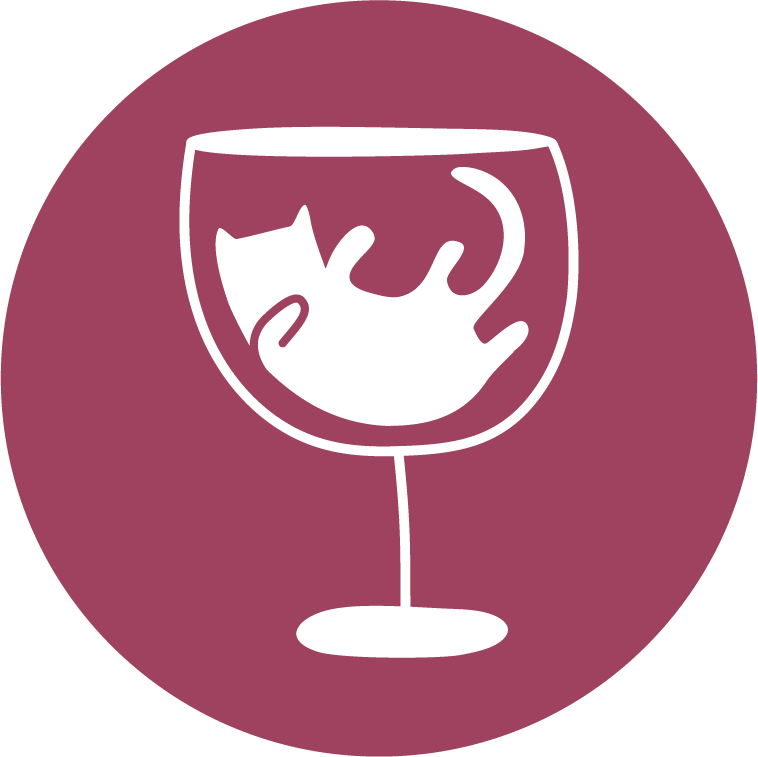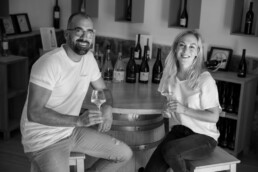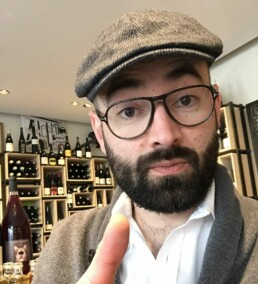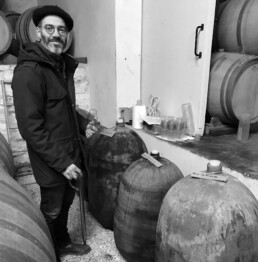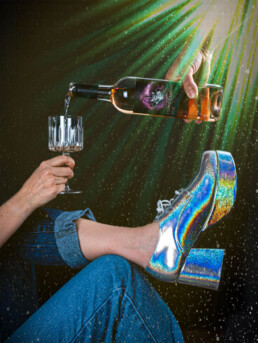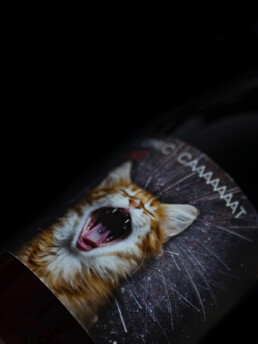Interview of Domaine de la Navicelle, partenaire of our Côtes de Provence « Sunny Caaaaaaat »
Making four-handed wine is about combining winegrowers’ know-how, rooted in their terroir, with that of a former globetrotter who tastes everything, smells everything (like a cat!).
For our summer rosé, we’re heading off to Provence, to the wonderful Domaine de la Navicelle, with its 21 hectares of vines cultivated with a desire to regenerate the ecosystem, respect nature. The vines are Organic and Biodynamic agriculture certified.
At the head of sales and production: Alice and Romain.
How would you describe the Domain in a few words?
Romain – La Navicelle: ecosystem, biodiversity, maritime influence are the main characteristics of the domain! All while very distinctely highlighting the notion of terroir.
How do you work in the vineyards and the cellar?
Romain – Organic farming and biodynamic methods are day-to-day for the team, with a particular preoccupation for the lifecycle of the soil. Zero chemical weeding, zero insecticides, 100% manual harvesting, super selective sorting, wine-making with perfect plot selection, these are the keys to the finesse and expression of our wines.
What do you think is essential for making a good wine?
Alice – Good grapes, harvested at the right time because it all starts on the vine! Then passion, patience and a touch of madness.
We cocreated Sunny Caaaaaaat. What was the best part (other than Christophe 😸) about cocreating this wine for the Caaaaaaat collection?
Alice – Christophe is passionate, like us! Working with him was a foregone conclusion. He knows how to translate our work, to explain it to his customers with spirit and talent. There’s great synergy and a human adventure above all. And also, we love cats!
What would you like to say to anyone who wants to work in the wine industry?
Alice – The world of wine is exciting, rich and multi-faceted, but paradoxically, also quite small. Nothing is easy, you need to be patient, curious, open and creative.
An ode to Provence?
Alice & Romain – Provence elates the senses! The smell of garrigue and lavender, cicada song and the sound of wind going through the pine trees, the changing lights, the bright colours… It amazes the nose, the taste buds and the eyes!
At Caaaaaaat, we like working with Domaine de la Navicelle. It is an uncommon Domain which places importance on the land and respecting nature. Having the desire to work with organic and biodynamic wine is quite rare for a Rosé from Provence!
They also have a distinctive characteristic: Tibouren! An unusual grape variety present in the crazy Sunny Caaaaaaatcuvée. And of course, as with all our four-handed wines, this variety is above all the result of cooperation between humans who like and respect each other.
Interview with the Founder: Christophe Kaczmarek
Who are you?
A wine buff, I’ve dedicated my life to it. First as an employee for wine companies, then I decided to give 100% of my time to wines I like, to a way of life I want to share.
In concrete terms, I started working in wine in 2007. I was looking for a student job, a friend pointed me to Le Repaire de Bacchus. He said “This is for you! Go see Paolo Bouca Nova and tell him I sent you”. I went to the wine shop on Rue Montorgueil, I found a mentor who became a friend, a love story with wine had begun. Before crossing the threshold of this wine shop, I didn’t know anything about wine. After six months of work, I knew wine would become my life. I went through different jobs around wine; grape picker, waiter, wine merchant, exports manager, wine bar manager (in New Zealand!), agent, trader… Today, I focus on what is most important to me: wines with a priority given to RESPECT.
In 2015 I created COQ AU VIN, an agency for wines made from organic and biodynamic agriculture, where my work focuses on ten key estates providing particular care to Mother Earth. Thanks to this reduced number of estates, I know the vineyards and the wines by heart, I share the winemakers’ passion, I follow their work closely and play a direct role.
Since with ten estates you cannot earn a proper living (and my head was brimming with ideas), I decided to create my own wines with the intention of creating a bridge between the worlds of wine. It was from this idea that the Caaaaaaat collection was born, a collection of independent wines co-produced with talented winemakers. The priority has always been “respect” for the fauna, flora, and human, any type of life, with total freedom of tone, container and content.
What types of wines are produced in the Caaaaaaat collection?
Freedom and Respect are the key words. We work on making wines as simply as possible; with fermented grape juice, organic, biodynamic wines, certified or not, with no added sulphur. And as “simplicity is the ultimate sophistication” (it wasn’t Caaaaaaat who said that, it was Leonardo da Vinci!), it requires a lot of care, time and the human touch. It’s a balancing act. In other words: making natural wine is painting a Rembrandt.
Why cats in space?
First of all, because supernovas are exceptional interstellar explosions. They release gas and dust heated to thousands of degrees, and therefore create amazing colours. Blue and green colours come from the emission of X-rays from the gas heated at thousands of degrees after deflagrations created by the explosion of the supernova. The red represents the boiling dust and the yellow comes from young stars, both detectable via infrared.
Secondly, cats are special. It makes us wonder: are they extra-terrestrials propelled from the edges of the galaxy from the explosion of the Kitty Caaaaaaat supernova?
Are you not afraid of unsettling the consumer, particularly in France?
As an entrepreneur, fear is baggage I prefer to not carry with me! Wine is a traditional sector where we don’t take enough risks. I took the gamble to go to an audience who is open-minded and would be stunned by the quality of the wines. Blind tasted, the Caaaaaaats knocked out the prejudices and snobbery. I’m delighted if our approach unsettles people and opens up a discussion, a debate, we love that in France!
Who is your target audience?
Haha! If I wasn’t a man lost in business, I would have a pre-planned answer… and I don’t have one! I want to maintain freedom regarding our productions, a target audience would change that. Creating a bridge between the worlds of wine compels us to not restrict ourselves to a specific audience. Seeing our wines being drunk by everyone (of legal drinking age), regardless of who they are, makes us happy.
What do you want to say through your concept?
If, with the Caaaaaaat collection, I can bring sensory pleasure and some fun, it’s a success! Like with Karate Caaaaaaat, which is a pure juice, a superb natural gastronomic wine.
Let’s go deeper. In this literal world, where ideas and individuals are stigmatised, you have to not take yourself seriously. We are rigorous, uncompromising in our work and it is precisely because I work with excellent, talented winemakers, that I can be side-lined. I’m comfortable with that. The wines we offer are made with extreme care (a lot more than certain “prestigious” wines).
Life is short and we are just dust, so let’s not waste time taking ourselves seriously.
How do you see the next three years?
In terms of production, the Caaaaaaat collection will offer nine wines, like a cat’s nine lives! There will be three whites, three rosés and three reds (passionate about numerology, I get you). I’ll continue to step off the beaten track with our co-productions, bringing artists into our projects, always going further in our environmental commitment by reducing bottle-weight as much as we can, making them refillable where possible, obviously maintaining our 100% Made in France approach, and of course bringing out underestimated French vineyards like with Cosmic Caaaaaaat Rosé Indigène or simply bringing another point of view to established areas like with Atomic Caaaaaaat… in short: they are going to be plentiful!
On a personal level: keep learning. Wine is an infinite world where we never stop learning, and this is even more true in the era of extremely rapid climate change. Expertise in wine is a label, placed by courtiers on their Pygmalions. The subject is vast and historical. Who can claim to know perfectly well 8000 years of working vines and making wine? This is all the beauty, the extraordinariness of wine, which I will continue to nourish my body and soul fir the next three years and my entire life.
What’s your favourite Caaaaaaat?
I like them all! I don’t want to offer a wine which I don’t enjoy from an organoleptic point of view. So no unconfessed favourite, but there will be a new wine soon: a skin-contact wine coming from a great plot of Domaine Entras. This Caaaaaaat has all everything a great wine has: it’s an orange wine, a skin-contact wine which required painstaking, manual, precise work. It’s a natural wine, matured with the greatest care (vat, barrels and clay amphora). It has a wonderful colour, it’s a wine to be enjoyed on every gourmet table! To do all this, we carried out another balancing act…
One sentence to sum up your connection to the world of wine
Day to day, I’m crazy about wine, a geek, a nerd, an enthusiast.
Professionally: if wine were a symphony, the land would be the score, the winemaker the musician, and I’m finding my place in the orchestra.
Final thoughts about the future?
Yes! I’m working on a project to plant vines, probably resistant grape varieties, also called “hybrids”, in Britany. This project will coexist with the Caaaaaaat collection which I enjoy so much. Cheers to good wine!
Interview with Michel Maestrojuan: Domaine Entras, Gascogne partner
Making a four-handed wine is about combining the winemakers’ expertise, which is rooted in the terroir, with that of a former globe-trotter who tastes everything, smells everything (like a cat).
For a red to accompany your meals, our Merlot brings back the prestige to this slandered grape variety, the famous Karate Caaaaaaat (which is between 45 and 120 times cheaper than Pétrus), we head of to Gascogne, to Domaine Entras with Michel Maestrojuan.
Can you describe yourself in a few words?
Tall, blond, long-haired and handsome… No, just kidding!
How did you get into winemaking?
My parents were winemakers. I’ve always been around the smell of fermentation (in the cellar), the vines in summer (organic farming), the bustle of harvesting… but I think I discovered the magic of wine in my Agricultural School’s wine club. A few years later, I went back to my childhood home and I threw myself into the winemaking adventure.
What is your work process like?
I manage 29 hectares of vineyards and 60 hectares of different crops like wheat, small spelt, soya, fenugreek, triticale, field beans. The entire estate was Organic Agriculture certified in 2021. I use plant covers for the vineyards and I replant various native hedge species. Little by little, I’m introducing biodynamic preparations to my crops and I’m analysing the results. I make wine with indigenous yeasts. In the wine cellar, I use vats, casks, tanks, earthenware jars. I apply a long aging period, with or without sulphur depending on the wine batch. I’m trying to progress freely in my choices and I think the wine benefits from that.
Is there a message behind your wines?
Drink me, I’m good and wholesome, I’m good for you.
What did you like about co-creating Caaaaaaat wines?
Meeting Christophe K, the free spirit, catalyst for wine and winemaker.
Any upcoming projects?
“Orange is the new wine”. Christophe and I are working on a new colourful collaboration at the moment (it is out, see here).
What’s the dream for a winemaker?
Making an easy drinking wine, with depth, you want to finish in one go.
Thank you Michel for taking the time to talk to us. Thanks to Domaine Entras for being our partner. We love you!
Creating a bridge between the different worlds of wine
With the Caaaaaaat wine collection, we want to create a bridge between the drinkers of mass-produced wine and those who drink natural wine. The former buy this type of wine for the price, the latter because of their way of life. Swimming in the middle of this ocean of wine are those who are guided by lots of criteria, including their tastes, their instincts, recommendations from critics they trust, friends…
Creating this bridge will not please everyone (after all, there’s always someone who objects, isn’t there?). It is easy to criticise when you are looking at the problem from the outside. It is very different when we experience it from the inside. We cannot ignore the fact that 88% of wine in France is purchased in supermarkets (source: La Revue de Vin de France), or the fact that natural wine cellars and bars are growing more than ever before (source: our eyes and ears). So the main obstacle in creating this bridge is ignorance. The kind that sounds like common sense: “why pay more than £5 for wine if the one I buy already is fine?”, “why don’t they only make natural wines?”, the kind that requires you to take an interest in a subject: “what are the differences between conventional, organic, biodynamic and natural agriculture?”.
When we criticise the winegrower who uses chemicals to make wine, we are fighting the wrong battle. When we criticise the consumer who buys their £5 wine or buys from the supermarket or wine from the chemical companies, we are fighting the wrong battle. The REAL battle is against ignorance and the chemical industry (at the very least the industry producing poison) which knows perfectly well what it is doing. Let’s not fight the surface level problem, this simplistic critique against winemakers and consumers. Of course, we all have a responsibility, but these people are hardly the bad guys.
Certification labels are flourishing, associations and other endorsements, responding to the surface of the problem, often adding to the confusion. It is an observation. We are not against them (on the contrary!), but we don’t think it is enough. As wine producers, we try to create a bridge between these two worlds of wine, this thousand-year old concoction which is a driving force for universal humanism.
By combatting this ignorance, which leads to social divisions, a form of tolerated obscurantism, we come up against resistance to change, fear, and the foundation of certainties on which it is built. In the infobesity which feeds social media, you have to specialise in order to stand out, to be visible. It is a pragmatic response, symptomatic of our information stuffed age, but also creates a lack of understanding for those who only want to hear ideas which reinforce their own. Learning comes from the new, the other. It is with nuance and patience that we progress into knowledge.
Explaining the different winemaking methods, and why they exist, requires time and has to be sexy enough to pull in an audience. Media stakeholders are working on this with a number of newspapers, magazines, blogs, columns and shows… our role is to offer knowledge through the product itself, the wine, a source of enjoyment, sharing and taste. In this process, we want to have fun, coach you with us, add some joie-de-vive; this is precisely why we are here (that, and throwing cats in space).
How to recognise a good/real natural wine?
If you are interested in natural wines, you’ve already got some of the information. So, let’s dig a little deeper, together, hand in hand.
Natural wine is a mentality, a way of life. It is about questioning how we live, our place on the planet. Natural wine is free, it’s naked, with no additives, no alterations, it reveals itself with its pros and cons (unlike Man, it doesn’t always have them!)
We talked about greenwashing, we can help you to counter it with some handy tips:
Tip no.1: be wary of companies using derivations of the word “natural”, which are pleasing on the ear. Regulations around natural wine are just starting to be implemented, these cheeky companies know that and play with their words.
Tip no.2: the phrase “with no added sulphites” is not enough. Again, the cheeky companies have found substitutes for sulphites, like ascorbic acid (and you won’t see it on the label).
Tip no.3: if the wine has not made the transition to organic or biodynamic agriculture, there is a good chance that they are not natural, a good chance but not totally impossible because some winemakers refuse the certifications and still work very well.
Tip no.4: the wine is cloudy (common with unfiltered wines).
Tip no.5: the wine contains some gas (this is natural, it comes from fermentation and it protects the wine).
Tip no.6: the wine smells funny when you open it ; this could be many things, often it is what we call the reduction, namely the reduction of oxygen, it is a good sign, the wine won’t be oxidised.
Tip no.7: all three at the same time!
Tip no.8: none of the above but the wine is bursting with fruit and goes down like no one’s business!
And if all that is just too exhausting, drink the natural Caaaaaaat wines (if you are here it’s surely because you already like them!), visit outlets who specialise in natural wines (they exist) and ask advice from your local wine merchant (support your local business!).
